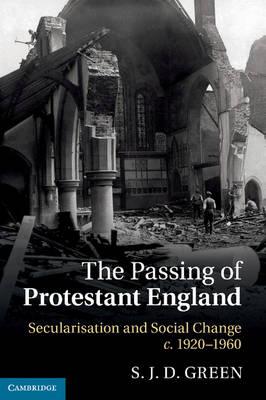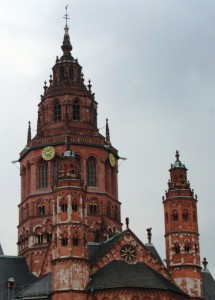Contemporary Church History Quarterly
Volume 19, Number 1 (March 2013)
Catholicism, Dictatorship and the World at War: The Significance of Cardinal Hinsley, 1935-1943
By Andrew Chandler, University of Chichester
This month brings the seventieth anniversary of the death of Cardinal Hinsley, Archbishop of Westminster. Hinsley’s time at the head of the Roman Catholic Church in England coincided with the appeasement of continental dictators, the final tumbling of all of Europe into war, the crisis of those critical months of 1940 when France fell and Britain faced catastrophe, the relentless expansion of the conflict across the face the world and then the turning of the tide against the Axis powers and the growing confidence of victory. It was the intensity with which Hinsley identified with the colossal dramas of his times that made him a national – and international – figure.
To any scholar of the relationship of religion and politics Hinsley presents an obvious interest. Yet this man who became archbishop of Westminster for eight tumultuous years has not attracted as much attention as he might have. Within a year of his death there was something like an ‘official’ biography by John Heenan, one of his students in Rome who would one day follow his master to that high office. This is very much a work of a particular kind and its judgments show the author to be working within the various confinements of his day and interest. There is a good drenching of piety, an emphasis on laudable qualities, and some firm avoidances. But Heenan knew the force of what his subject had established. In beginning with the weighty funeral which Church and State accorded to Hinsley in March 1943, he shows a Roman Catholic Church that had truly arrived as a dimension of national life. For this was a great occasion and a vast congregation. The Government, he exults, was not merely represented. It actually came, altogether. Even so, the wait for a second biography would be a long one. James Hagerty’s admirable 2008 study, Cardinal Hinsley: Priest and Patriot, provided a more dispassionate analysis, and often a more extensive one.
Hinsley has attracted only sporadic attention from scholars. Adrian Hastings paid a warm tribute in his lively History of English Christianity, 1920-1985 (London, 1986) while Thomas Moloney placed Hinsley firmly in the framework of solid diplomacy, in Westminster, Whitehall and the Vatican: The Role of Cardinal Hinsley 1935-1943 (in 1985). Moloney’s often elegant book leaves the historian of international politics much in his debt, for he clearly did a good deal of honest toil in the archives and, in so doing, widened and developed our picture. There is now a valuable overview by Michael Gaine in the new Oxford Dictionary of National Biography. To extend the range of this will not be quite straightforward because, as Heenan found in 1944, there is not very much to go on. Hinsley was not a man who thought of filing papers and meeting the requirements of future historians. He did not bother to preserve his correspondence once a matter was settled. Heenan suspected that he would not even have expected a biography. He was private, modest and utterly given to the present moment. But he was observed sympathetically by a few who were prepared to commit something of the man to paper. The Bishop of Chichester, George Bell, recorded a significant tribute in the pages of Blackfriars in May 1943. This friendship of a Cardinal and an Anglican bishop is suggestive. Later that great insider, David Mathew, wrote wisely and sensitively of Hinsley in the later editions of his striking study, Catholicism in England: The Portrait of a Minority: its Culture and Tradition (third edition, 1955).
The verdict that the great weight of Hinsley’s long life came to rest in those late, crucial years, between 1935 and 1943, is irresistible, although in his biography of 2008 James Hagerty does well to retrieve the earlier years and readjust at least some of our perspectives. In fact, this was really rather an odd career, much of it committed to one modest institution, the Venerabile in Rome and then to a long, roving brief as Apostolic Delegate in Africa. There was not a great deal in all this to make any historian of great affairs sit up sharply and take note. But, crucially, Hinsley was enough of an insider in Rome to be in the way of something splendid if it happened to occur. In 1935, when he was 69 years old, it certainly did.
The leadership of the English Roman Catholic community had for over thirty years rested in the hands of capable Cardinal Bourne. But the impression left by those decades is something dour, brittle, dry and introverted. This was a Catholic community still not quite at home in national society; one often defined by a deeply regional character, a particular sociology (Irish, working class, aristocratic and rather little in between), a rather petulant striving for legitimation and a bristling grievance that the Establishment still refused to acknowledge its existence at State occasions. Nor was it was not a community always at peace with itself. The English bishops were notoriously querulous – and Rome knew about it. In 1935 many English Catholics may have been baffled by the appointment as Archbishop of Westminster of a man so little known in his home country. But Pius XI knew his man and would have no other. When Hinsley himself had recovered from the shock he quite simply took on a new lease of life. This sudden emergence from the background at such a doom-laden hour had something of the Churchillian epic about it. Hinsley must have wondered if the whole of his life had been merely a preparation for this moment.
Hinsley looked like a safe pair of hands. He was devoted to the Papacy. He had done nothing disconcerting. He was amiable and had friends in high places. Moreover, he was theologically a conservative who had no time for Modernism. None of this indicated any bracing, liberalising attitudes or obvious liabilities. Yet there were quiet hints of something bolder. His sympathies were too deeply rooted in the conditions of the poor to accept too readily the blandishments of the Right. When a politician had visited the Venerabile and amiably told the ordinands that on their return to England it would be their duty to vote Conservative Hinsley brusquely ended the occasion. The Church was not his whole world: he was perfectly capable at ecclesiastical affairs but they did not excite him. He was stirred by the spectacle of oppression and he hated to see righteousness persecuted. Wherever the Church was threatened his ears pricked up and he was all attention and involvement. Yet we still know too little of what he made of Italian Fascism when he lived in Rome itself. Mathew thought he did not really understand Italians altogether. Heenan simply observed that when the Mussolini regime sought to redesign the centre of Rome and gobble up at least part of the Venerabile Hinsley did his best to thwart the plan. He would, not doubt, have done the same if a comparable civic engineering project had been dreamed up by any other power.
The personal traits of an archbishop are bound to be eulogized, but Hinsley’s characteristics were suggestive. Mathew thought that he simply lacked pride or vanity. He lived as simply as he could; he needed, and relished, the company of all sorts and conditions of people; as a friend he was found to be kindly, loyal, paternal. He listened well. It seems that Hinsley was quite at home with Chapel as well as Church people. Mathew thought Hinsley ‘never thought in denominational terms’. He did not much care for great churches – and Westminster Cathedral is something strenuous in these terms – but grumbled about mere ‘bricks and mortar’ and sought active apostolic work. Instead he was happiest in settings that were modest or quietly domestic. He sought never to waste time; some found him always in a hurry to use well what was left to him. He worked like a Trojan and prayed constantly. When George Bell stayed with him in his home in Hare Street he found ‘the next morning I felt a richer man, richer spiritually as well as richer in wisdom’. He could be stern but was more often found to be compassionate. He was uninterested in splendour and pageantry. When he left a note for his executors it was found to request no pomp at his funeral but only a low Mass, ‘no profusion of candles’, ‘the least expense possible’, a burial ‘wherever most convenient’. None of this, of course, he got.
Hinsley was devoted to the Papacy and this must have been at least one reason why Pius XI put him in Westminster. But he was not over-fascinated by church affairs and the perspectives that he brought to the job were generous ones. Hinsley disavowed purely clerical company and his view of the Roman Catholic Church was by conviction a laicizing one. He looked for things of substance, in whatever form they arose, not the mere presentation of clerical appearances. Hastings observed, ‘No archiepiscopate was effectively less ultramontane or clericalist.’ Hinsley was ardent in his support for Catholic Action. The Tablet had long ago been incarcerated by a defensive clerical caste; now he promptly turned it over to the laity and watched it prosper under Douglas Woodruff. He enjoyed G.K. Chesterton, looked up to Christopher Dawson and Arnold Toynbee and fostered the work of the young Barbara Ward. He would have liked Ronald Knox to be a bishop.
Above all, Hinsley brought something of the world to Westminster – but the world was just about to shout its demands at the politicians in Parliament and the diplomats in Whitehall anyway. He lost no time in pinning his colours to the shaky mast of the League of Nations but this brought no strong reassurance. His arrival had coincided with the hour of its most severe test. When Mussolini attacked Abyssinia in October 1935 Hinsley faced a fundamental challenge. What should he now say? If British opinion was indignant should he join the chorus and show the loyalty of the Church? If he stood firmly by the Pope he must know that the neutrality of the Vatican was incomprehensible to the critics of dictators and aggressors. The Archbishop of Canterbury was powerful against the invasion; a senior Anglican bishop like Henson of Durham was positively incandescent. To make matters worse for Hinsley he was caught up in a clumsy, botched attempt at intervention in Britain by the Vatican itself. For his part he had no illusions about Abyssinia, whatever his calculations. This was an act of aggression and, as Hagerty shows, he was ready to say so publicly. There was a letter to the Times. And then there was a sermon in Golders Green.
‘Indignation’, Hinsley declared at Golders Green, ‘knows no bounds when we see that Africa, that ill-used continent of practically unarmed people, is made the focus and playground of scientific slaughter.’ But what could the Pope actually do?
He is a helpless old man with a small police force to guard himself, to guard the priceless art and archaeological treasures of the Vatican, and to protect his diminutive state which ensures his due independence in the exercise of his universal right and duty to teach and guide his followers of all races. Can he denounce or coerce a neighbouring power – a power armed with absolute control of everything and with every modern instrument of force? He could excommunicate and place under interdict! Yes! And thus make war with his neighbour inevitable, besides upsetting the peace and consciences of the great mass of Italians with the result of a fierce anti-clerical outbreak. Spiritual penalties are for the correction of those who are knowingly guilty. And spiritual penalties for a world daily more godless are of little avail.
The Pope was not an arbitrator. He was explicitly excluded from any such role by the secret London pact of 1915. Only if both sides of a dispute invited him to judge them could he do so.
Parts of the British press made much of this characterisation of the Pope. Pius XI himself was not flattered. But what really caused the ecclesiastics in Rome to fidget nervously was Hinsley’s condemnation of the ideology which launched this invasion. Fascism, he had pronounced, deified Caesar, showed tyranny, made ‘the individual a pawn on the chessboard of absolutism’. This also alienated a significant number of English Catholics, bishops among them, who openly favoured the Duce. There was talk of bringing the Archbishop of Westminster to heel – and Hinsley did indeed fall silent, for a time. When he turned to Heenan for advice in writing speeches he was seen to be shaken by the controversy. But in retrospect the sermon at Golders Green sounds like the stray, opening shot in a far longer war.
Abyssinia was a cause of much heart-searching amongst British Catholics and Protestants alike. The Spanish Civil War presented dilemmas no less painful. Heenan the careful biographer buried this quietly; Moloney and Hagerty offer sustained reflections. Hinsley, they find, had to find a credible place between that position held by many English Catholics, who trembled at the growth of communism and cheered for Franco, and a vigorous left-leaning public opinion which deplored fascism and the forces of reaction. Above all, he was horrified by the onslaught against the Church in Spain and knew a good deal about it. He let it be known that he thought the Nationalist cause a crusade. But beyond this he was decidedly circumspect, maintaining a purposeful neutrality, refusing to indulge those who lauded Franco or accept the criticisms of those who deplored the Right and raged at any evidence of complicity. Meanwhile, he turned his attentions to the plight of refugee children. When Franco was victorious Hinsley received a signed photograph, a gift arranged by an English admirer. ‘I look upon you as the great defender of true Spain, the country of Catholic principles where social justice and charity will be applied for the common good under a firm peace-loving government.’ For all this, Moloney insists that Hinsley was ‘no third order Falangist’. In 1942 he would take up the cause of persecuted Spanish protestants too. It was often heard that to condemn Communists involved a support for Fascists. Although he had favoured Franco, Hinsley was determined not to accept that anti-communism revealed any shade of Fascism. He viewed both as enemies. His task now was to show that Catholicism voiced the cause of liberty and the maintenance of the common good.
At home Hinsley the Archbishop appeared rudely caught between the campaigns of conflicting parties. Some parts of the Catholic press was likely to shout any embarrassment when it came to foreign affairs. Abroad, the troubled consistencies of Vatican policy had made life no easier for him. But when he looked at Germany Hinsley was far more the critic. He was ready to follow the lead given by Mit brennender Sorge in March 1937. That September he published a protesting letter in the Times. Hinsley himself had been present when on Christmas Eve in 1937 Pope Pius XI said to a gathering of cardinals. ‘We know that there is in Germany a grievous persecution, and more, that there has rarely been a persecution more serious, so painful, and so disastrous in its widespread effects. This is a persecution in which neither the exercise of force, not the pressure of threats, not the subterfuges of cunning and artifice have been spared.’ By December 1938 he was taking to the platform at the Albert Hall to protest against the persecution of the Jews where he deplored that Nero was ‘a model of justice compared to the Führer of the German Reich’. He approved thoroughly of Chamberlain and applauded him as a peace-maker. But he did not want Hitler accommodated at the price of justice. In a private meeting with the Archbishop of Canterbury, Cosmo Lang (with whom he had much in common and in whom he found a growing friendship) he agreed that no colonies could be returned to a government which persecuted other races. But unlike Lang he could have nothing to do with the idea that to rein Hitler in a new diplomatic understanding with the Soviet Union might be deemed necessary. There were other public speeches, no less vigorous and confrontational. National opinion was thickening against appeasement and now the archbishop of Westminster was positively stirring the pot.
After the painful ambiguities and compromises of the age of appeasement, the coming of war brought some vital clarifications. Hinsley set to work with a will, making public speeches and BBC broadcasts which were unequivocal in their denunciations of the enemy and rich in their confidence in British justice. And Hinsley certainly was patriotic. He had grown up with patriotism; he must have taken on something of the patriotic yearning of the long-term ex-patriate; he had admired British colonial administration in Africa; he viewed national institutions with great loyalty. Now a robust patriotism in high office in the circumstance of 1935-43 was a high virtue, indeed a basic necessity. Hinsley was realistic enough to know that it was patriotism which in no small measure stood between Hitler and Whitehall. ‘I’m glad we’re alone’, he remarked to Churchill after the fall of France. When Churchill asked ‘Why?’ Hinsley replied, ‘Englishmen fight best when they have got their backs to the wall.’ There is more than a sense of rejoicing at the coming of superbly heroic moment in all this. But if Hinsley’s patriotism is firmly acknowledged there is at least a danger that it confines him to a national landscape and merely exposes him to suspicions of another kind; that he was a prelate too close to the governing powers (even if they happened, on that occasion, to be right and just). But Hinsley does present a bigger argument than this and he does belong to a wider picture.
Heenan observed that Hinsley was a convinced democrat who preferred to live among the poor. The age of the dictators stirred deeply his affinity with the heroic and the just cause. Mathew found that Hinsley positively thirsted after justice and was ‘a great hater of oppression’. There remains something visceral in this palpable hatred of tyranny, a restless determination to stand against it, an abiding compassion for its victims. When an English edition was prepared of the reports documenting the German occupation of Poland sent by Cardinal Hlond to Rome it was Hinsley who contributed the foreword. In his last years Mathew thought that the new book which affected him most deeply was Professor Binchy’s Church and State in Fascist Italy. Mathew recognized that ‘the quality that most appealed to the Cardinal was reckless and self-sacrificing moral goodness, and it was this that led to his always deepening affection for the Bishop of Chichester’. Bell was convinced that the churches must sink their differences over doctrines and questions of order and unite urgently against against the new foe of totalitarianism. Hinsley promptly agreed. For a while, at least, there was the ecumenical excitement of the ‘Sword of the Spirit’ movement and a glimmer of authentic ecumenical progress in wartime. When, at a meeting of the movement in May 1941, Bell whispered to Hinsley that perhaps Protestants and Catholics might say together the Lord’s Prayer, Hinsley was ready to lead it – a quiet revolution, no doubt, but an authentic one, even so. His bishops disagreed with most of this and yet they never squabbled with him. It was enough, after 1943, to pretend that it had never happened. Without Hinsley the Sword of the Spirit had nowhere to go and it was soon only the pious memory of a few stranded progressives.
Hinsley in wartime took his place in a national consensus against Nazism and Fascism. In no way did he see himself as an individualist or a prophet. He was equally adamant that his views found their place within the body of Catholic thought, as history and international life revealed it, not on the margin. In a broadcast of 10 December 1939 Hinsley justified his own conviction that Britain’s cause was just by asserting, ‘I have before my mind the lessons of history and also the great traditional body of doctrine which sets forth for the moral guidance of mankind principles which are above both national and racial interests. These principles are clearly stated in the great pastoral letters of the Popes from Leo XIII to the present pontiff ….’ It was Benedict XV who had issued the ‘peace note’ of 1917, affirming the ‘supremacy of right over might, and also for a real and agreed peace between combatants whether victors or vanquished.’
Bell found Hinsley eager for the regeneration of Europe. What had made Europe great in civilization? It was Christianity. And it was Christianity which had formed a reverence for the individual, a belief in the family and, out of this, the very nation which had created Europe. In March 1940 he found much of significance in the anniversary of St Gregory the Great, a Pope who inherited a civilization in chaos and ruins and yet claimed a vision of Christendom. Now in the Soviet Union ‘the individual and his conscience, and therefore God and His supreme rights, are to be “liquidated,”’ not even with a nod to any theory at all, whereas in Nazi Germany the same effect was sought in the name of Race, ‘of the physical blood which courses pure, according to the Myth, in the veins of Aryans alone, and, among Aryans, of Germans only.’ If a society rejected God this was the kind of thing that might be expected. ‘Rome only has been the source of full civilization, that is, the perfect harmonious relating of individual to Society, of State with Church, of time with eternity.’
This was what Moscow and Berlin sought to destroy, in Poland and in Finland. With such powers as these there could be no compromise. He viewed the ‘martyrdom’ of Poland with ‘deep indignation’: it was his duty to ‘protest aloud’ against such persecution of Catholic and Orthodox Christians as he had against such persecution in Germany itself. ‘Liberty must be our goal, liberty which is not now possible in Russia and in Germany. The thirty-seven million Catholics living under the Government of the Reich are constantly in my thoughts. They, and the members of the Evangelical Confessional Church, have been among the principal victims of the Nazi regime.’
Hinsley insisted that in all of this he stood by the Popes, not against them. First there was Mit brennender Sorge in 1937, then the encyclical Divini Redemptoris. Both of these were the work of Pius XI. To them Pius XII had added Summi Pontificatus and the Five Peace Points of Christmas 1939. When it was asserted that other Catholics spoken in contradiction of his views he simply denied it. He could turn to Mit brennender Sorge again. He could look at the letter issued by the German bishops at Fulda in August 1938. ‘I am’, he maintained, ‘in good company when I denounce the principles and methods of Nazism in its tramp through Europe.’ What Hinsley took from Summi Pontificatus was the defence of the ‘sacred rights’ of the family against ‘the aggression of the State and against the doctrines of immoral propaganda’. He was clear that it was the place of the Catholic Church to stand firmly against this fundamental enemy and he knew that he occupied a significant place within an international argument, one that concerned the credibility of the whole Church. When he heard that Nazi propaganda in Germany and in the Netherlands had complained that he had merely converted the words of two popes to the service of the cause of Britain he was more than ready to confute them.
Hinsley had been as much a denouncer of the Soviet Union as Nazi Germany. As James Hagerty acknowledges, the new alignment of powers after Barbarossa ‘seriously compromised’ him and he made no easy accommodation. Indeed, he would not conform to the new official line if he could possibly help it. He sought to distinguish between the Russian people and their state, insisting that all expressions of support were for the former and not the latter. On this he came to rely rather heavily. How he would have managed if he had lived to see the end of the war is difficult to judge. Heenan found that Hinsley ‘loved the Jewish race’. When he heard that he was scored by Nazi propaganda as a ‘friend of the Jewish people’ he was evidently proud of the title. He was ready to join the new Council of Christians and Jews with Archbishop Temple and the Chief Rabbi, J.H. Hertz. His final public statement was produced when he was dying, on 1 March 1943, not for a British audience but for the World Jewish Congress in New York: ‘In unison with the voice of indignant protest that cries aloud from all human hearts and in accord with the declarations of the Church, I denounce with utmost vigour the persecution of the Jews by the Nazi oppressors … Words are weak and cold; deeds and speedy deeds are needed to put a stop to this brutal campaign for the extermination of a whole race ….’
The historian may turn again to Hinsley with many questions. What remains clear is that Hinsley played a vivid part in the international encounter between Catholicism and totalitarianism, that he sought to show the two as implacable enemies and that he sought to claim an alignment between the Church and democracy and liberty. Within this he struggled as much as most to find a lasting consistency, not least in juggling his responsibilities to Vatican policy, national diplomacy and domestic opinion. Arguably, he would have wished to be remembered as an archbishop who stood resolutely against tyranny and persecution, for it was in this landscape in which he truly found himself. He did much to deserve this. Those who seek to condemn the Church at large for its acquiescence in the evils of dictatorship during the Second World War still have something in him to reckon with. Insofar as he drew justification from the words and interventions of the Papacy he might, too, shed at least some light on the value of that much disputed record.
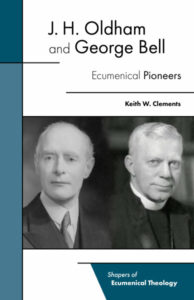 Christian internationalism has yet to find a secure place in the various histories of twentieth-century churches. Very largely this is due to a persistent emphasis on national categories and narratives, but denominational perspectives have also fashioned a great deal of what we expect to find in the foreground. All too often, Bell and Oldham may be observed, usually dutifully and briefly, hovering in the background of anything other than ecumenical surveys. In the final volume of the recent Oxford History of Anglicanism (OUP, 2019), Bell flits about here and there, but there is no very confident sense of where to put him for very long. Meanwhile, Oldham, the United Free Church layman, has almost vanished from ecclesiastical memory altogether. This is an authentic tragedy because it indicates how horizons have contracted across the western Protestant churches in the half-century since their deaths.
Christian internationalism has yet to find a secure place in the various histories of twentieth-century churches. Very largely this is due to a persistent emphasis on national categories and narratives, but denominational perspectives have also fashioned a great deal of what we expect to find in the foreground. All too often, Bell and Oldham may be observed, usually dutifully and briefly, hovering in the background of anything other than ecumenical surveys. In the final volume of the recent Oxford History of Anglicanism (OUP, 2019), Bell flits about here and there, but there is no very confident sense of where to put him for very long. Meanwhile, Oldham, the United Free Church layman, has almost vanished from ecclesiastical memory altogether. This is an authentic tragedy because it indicates how horizons have contracted across the western Protestant churches in the half-century since their deaths.
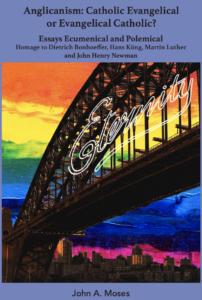 In his foreword to the book, Mark Lindsay welcomes Moses warmly into the realm of contemporary theological angst, affirming the proper place of a historian in all such things. This may seem all too obvious, but then the authority of the historical craft, and of historical knowledge altogether, has for some years now become increasingly obscure to those who oversee the life and work of most of our Protestant churches. When a moment of vital significance turns up historians are seldom to be found in the counsels of authority. If anything, they are likely to be deliberately excluded from them, though they might now and then be recruited to write introductory paragraphs. Evidently, we are all expected to return to a vigorous state of primitive Christianity as though nothing of significance has occurred across the intervening centuries. But there may be other reasons to maintain this state of ignorance. The historian of the modern church is not quite a tame creature. The churches prefer a show of loyalty, while those in charge of them care not at all to be criticised. Historians tend to do this rather freely, particularly when provoked. The historian of the Reformation may unhelpfully point out doctrinal contradictions or emphasize acts of violence. The historian of secularization will certainly prove to be bad for morale. As for the historians of the Third Reich, it is much safer to leave them in their university departments than to invite them to observe patterns and parallels. And why should there be any, after all?
In his foreword to the book, Mark Lindsay welcomes Moses warmly into the realm of contemporary theological angst, affirming the proper place of a historian in all such things. This may seem all too obvious, but then the authority of the historical craft, and of historical knowledge altogether, has for some years now become increasingly obscure to those who oversee the life and work of most of our Protestant churches. When a moment of vital significance turns up historians are seldom to be found in the counsels of authority. If anything, they are likely to be deliberately excluded from them, though they might now and then be recruited to write introductory paragraphs. Evidently, we are all expected to return to a vigorous state of primitive Christianity as though nothing of significance has occurred across the intervening centuries. But there may be other reasons to maintain this state of ignorance. The historian of the modern church is not quite a tame creature. The churches prefer a show of loyalty, while those in charge of them care not at all to be criticised. Historians tend to do this rather freely, particularly when provoked. The historian of the Reformation may unhelpfully point out doctrinal contradictions or emphasize acts of violence. The historian of secularization will certainly prove to be bad for morale. As for the historians of the Third Reich, it is much safer to leave them in their university departments than to invite them to observe patterns and parallels. And why should there be any, after all?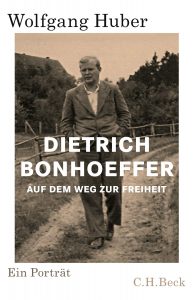 The structure of the book is not unduly distinctive, but it sets out clearly the overall argument and method. Huber’s Bonhoeffer is certainly a big and complex figure. He is also one full of contrasts and the author delights in framing and exploring them. An introductory section evokes the figure of Bonhoeffer as we might first encounter him in a variety of places, not least over the Great West Door of Westminster Abbey. There follows a section on Bonhoeffer’s background and early formation and then another three on his early work in the contexts of university and church life, the first situating him firmly in the landscapes of German thought, the second examining a theology of grace which was deeply rooted in the precepts of Lutheranism, and the third discussing the place of the Bible in a world of maturing historical criticism. Each of these sections present dualities which already defined so much in Bonhoeffer’s work (‘Individual spirituality or Society’; ‘The Church of the World or the Church of the Word’; ‘Acting justly and waiting for God’s own time’; ‘The Historical Jesus or the Jesus of Today’). The young Bonhoeffer is certainly very much at home in the intellectual landscapes of German Lutheranism but the emerging vision is an open one and there is no knowing where it will lead.
The structure of the book is not unduly distinctive, but it sets out clearly the overall argument and method. Huber’s Bonhoeffer is certainly a big and complex figure. He is also one full of contrasts and the author delights in framing and exploring them. An introductory section evokes the figure of Bonhoeffer as we might first encounter him in a variety of places, not least over the Great West Door of Westminster Abbey. There follows a section on Bonhoeffer’s background and early formation and then another three on his early work in the contexts of university and church life, the first situating him firmly in the landscapes of German thought, the second examining a theology of grace which was deeply rooted in the precepts of Lutheranism, and the third discussing the place of the Bible in a world of maturing historical criticism. Each of these sections present dualities which already defined so much in Bonhoeffer’s work (‘Individual spirituality or Society’; ‘The Church of the World or the Church of the Word’; ‘Acting justly and waiting for God’s own time’; ‘The Historical Jesus or the Jesus of Today’). The young Bonhoeffer is certainly very much at home in the intellectual landscapes of German Lutheranism but the emerging vision is an open one and there is no knowing where it will lead. The suppression of the Bruderhof in Nazi Germany was not unobserved in Britain: there were protests and interventions by figures as diverse as the eminent Anglican laymen Sir Wyndham Deedes and the Baptist internationalist J.H. Rushbrooke. Friends of all kinds now proved effective, particularly in practicalities. By May 1936, the Bruderhof could be found in a farm near Ashton Keynes in the Cotswolds where a new community comprised sixteen Germans, fourteen British friends, and one Austrian. At the height of its quiet prosperity there, in October 1939, the community included as many as 119 Germans, 116 British members, 30 Swiss, 17 Austrians, and stray individuals from the Netherlands, Czechoslovakia, France, Sweden, Italy, and Turkey. All came with their own stories and for their own reasons. All sought to be useful. A miner from the coalfields of Durham cycled three hundred miles to join them and was promptly set to work picking potatoes; another new arrival was a Lancashire poultry farmer who was also a Methodist lay preacher and admirer of the Indian Christian mystic Sundar Singh. In choosing the Cotswolds, a deeply rural area which possessed something of the character of an English arcadia, the community chose well. Birmingham, the second city of the country and a bastion of Quakerism and Free church life and worship, was not far away. Ashton Keynes also had a railway station. Visitors and longer-term guests could come and go as they chose – and they did.
The suppression of the Bruderhof in Nazi Germany was not unobserved in Britain: there were protests and interventions by figures as diverse as the eminent Anglican laymen Sir Wyndham Deedes and the Baptist internationalist J.H. Rushbrooke. Friends of all kinds now proved effective, particularly in practicalities. By May 1936, the Bruderhof could be found in a farm near Ashton Keynes in the Cotswolds where a new community comprised sixteen Germans, fourteen British friends, and one Austrian. At the height of its quiet prosperity there, in October 1939, the community included as many as 119 Germans, 116 British members, 30 Swiss, 17 Austrians, and stray individuals from the Netherlands, Czechoslovakia, France, Sweden, Italy, and Turkey. All came with their own stories and for their own reasons. All sought to be useful. A miner from the coalfields of Durham cycled three hundred miles to join them and was promptly set to work picking potatoes; another new arrival was a Lancashire poultry farmer who was also a Methodist lay preacher and admirer of the Indian Christian mystic Sundar Singh. In choosing the Cotswolds, a deeply rural area which possessed something of the character of an English arcadia, the community chose well. Birmingham, the second city of the country and a bastion of Quakerism and Free church life and worship, was not far away. Ashton Keynes also had a railway station. Visitors and longer-term guests could come and go as they chose – and they did.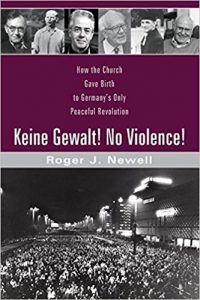 This sense of observing and interpreting like a guest whose eyes are being opened by degrees to something new and unexpected is certainly one of the strengths of the book. It makes Newell himself something of a tourist – in the best sense – and equally an attractive introducer to readers coming to the same questions afresh. The vital presence at the heart of the story is the pastor of the Nikolaikirche himself, Christian Führer, who in 1989 opened the doors of the church to all people – and, in particular, to many who were disaffected by the Communist state – so that they could meet together, light candles, share what was important to them all and find new ways to insist upon these things in a world of repression and intimidation.
This sense of observing and interpreting like a guest whose eyes are being opened by degrees to something new and unexpected is certainly one of the strengths of the book. It makes Newell himself something of a tourist – in the best sense – and equally an attractive introducer to readers coming to the same questions afresh. The vital presence at the heart of the story is the pastor of the Nikolaikirche himself, Christian Führer, who in 1989 opened the doors of the church to all people – and, in particular, to many who were disaffected by the Communist state – so that they could meet together, light candles, share what was important to them all and find new ways to insist upon these things in a world of repression and intimidation.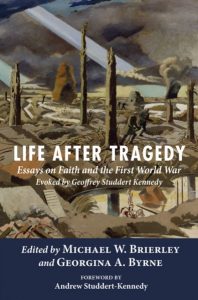 Studdert Kennedy, or ‘Woodbine Willie’, as he was affectionately known by soldiers, has long been the most well-known of the British wartime chaplains. He has attracted the attention of scholars of various kinds for his poetry (The Unutterable Beauty, published in 1927, remains much admired in some quarters), his trenchant criticisms of the status quo, his uncompromising socialism, his pungent scepticism of authority (one of his books was simply called Lies), and his determination that the ghastliness of war must surely and eventually yield a better world. But he was also the embodiment of courage and unselfconscious sacrifice (he won the Military Cross) and his early death, exhausted, at the age of 45, presented something of the quality of a martyrdom—not so much to the powers of the age but perhaps to the whole age in which he lived. Westminster Abbey notoriously turned down the idea of hosting his funeral. One suspects that Studdert Kennedy would have been delighted by the compliment.
Studdert Kennedy, or ‘Woodbine Willie’, as he was affectionately known by soldiers, has long been the most well-known of the British wartime chaplains. He has attracted the attention of scholars of various kinds for his poetry (The Unutterable Beauty, published in 1927, remains much admired in some quarters), his trenchant criticisms of the status quo, his uncompromising socialism, his pungent scepticism of authority (one of his books was simply called Lies), and his determination that the ghastliness of war must surely and eventually yield a better world. But he was also the embodiment of courage and unselfconscious sacrifice (he won the Military Cross) and his early death, exhausted, at the age of 45, presented something of the quality of a martyrdom—not so much to the powers of the age but perhaps to the whole age in which he lived. Westminster Abbey notoriously turned down the idea of hosting his funeral. One suspects that Studdert Kennedy would have been delighted by the compliment.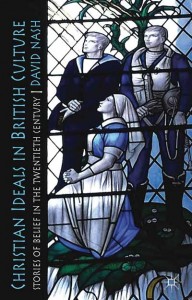 The cover announces the character of the theme: it is the image of a stained glass window in Worcester Cathedral showing three resolute figures looking up towards the sky, intent, devout, broadly sanguine. One is a nurse and the other two are men of the Royal Navy and the Royal Air Force. The task that David Nash has set himself here is a striking one: in what kinds of narratives might the historian find the relationship between religious faith and active public life in the British twentieth century? How are we to locate the dimension of personal faith in the discussions and dramas of society at large? How are we to know when it is there – or when it is not?
The cover announces the character of the theme: it is the image of a stained glass window in Worcester Cathedral showing three resolute figures looking up towards the sky, intent, devout, broadly sanguine. One is a nurse and the other two are men of the Royal Navy and the Royal Air Force. The task that David Nash has set himself here is a striking one: in what kinds of narratives might the historian find the relationship between religious faith and active public life in the British twentieth century? How are we to locate the dimension of personal faith in the discussions and dramas of society at large? How are we to know when it is there – or when it is not?